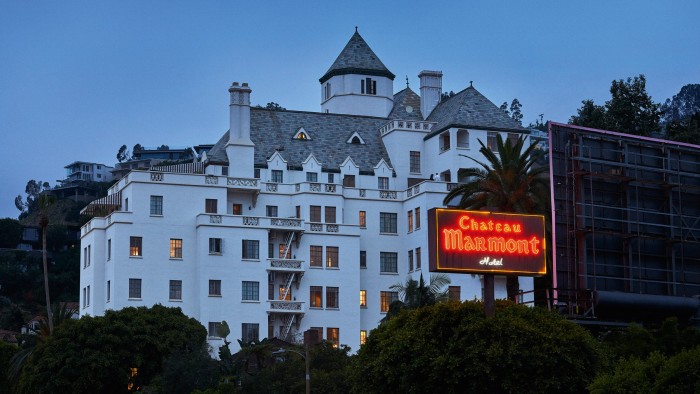It is the castle on the hill, the grand dame of Tinseltown, the old lady of La-La Land. For almost 100 years, Chateau Marmont has been an A-list attraction. Everybody who is anybody has stayed there, and anybody who wants to be somebody goes there.
The reason is simple: in a city where everyone is constantly judged, evaluated and placed into competition with each other, at the Chateau, all bets are off. It is a secluded oasis: a place where you can be yourself. Or, better yet, be somebody else. Hotels are by nature transient spaces that allow you to reinvent, experiment and risk trying things you might not at home. The Chateau in particular is a kind of halfway house, a perfect bardo, a suspension of reality.

Its history as a place of freedom for the famous is memorialised in the Chateau Marmont Hollywood Handbook, the official account of the hotel’s history and a cult classic, now back in print a year in anticipation of its upcoming 30th anniversary. Edited by the hotel’s owner, André Balazs, the book is a juicy memoir capturing the stories of those who have been in residence there: Marilyn Monroe, Howard Hughes, Greta Garbo, James Dean, Elizabeth Taylor, F Scott Fitzgerald, Hunter S Thompson, Keanu Reeves, Anthony Kiedis and Bret Easton Ellis. The images, which include Julie Delpy doing her ironing and cohorts of women dancing through the gardens, remind us that art and play are inexorably bound and that nothing inventive or new comes from following the rules.


The Chateau was built in 1929 as the first earthquake-proof building in Los Angeles, modelled after the Château d’Amboise, a one-time home of Mary, Queen of Scots, in France’s Loire Valley. It garnered a reputation as the place to go to misbehave following the Hays Code of the 1930s, a form of self-imposed censorship enacted by the Hollywood studios that disallowed nudity, sex and interracial relationships in their movies. Amid this climate, the hotel became the perfect place to hide, with its thick walls, privacy from the street and famously discreet staff. As Columbia Pictures co-founder Harry Cohn said in 1939: “If you must get in trouble, do it at the Chateau Marmont.” (The hotel also managed to get itself into trouble in 2020 when the pandemic hit and longtime employees were abruptly laid off, leading to a boycott supported by many celebrities. Fences have since been mended, and the hotel workers are now unionised.)


The Chateau attracts outsiders of all sorts: artists, writers, misfits and anyone on the edge, those feeling precarious, disenfranchised or unseen, and even U2’s The Edge. It is a home away from home for those seeking refuge – from the public, and sometimes from themselves. The Hollywood Handbook reports that Robert Mitchum, pictured in the book doing the washing up in one of the Chateau’s apartments, was busted while in residence for smoking a spliff. Newspaper cuttings from 1982 report that actor John Belushi had died of a drug overdose in Bungalow 3. More recently, Jay-Z and Beyoncé threw an Oscars afterparty in the building’s garage. Miley Cyrus celebrated her 31st birthday at the hotel with an impromptu lobby concert. And this year’s Golden Eve Party, the night before the Golden Globes, attracted so many fans and paparazzi that the street outside the hotel had to be closed off.

I have found it to be an exceptionally creative environment. My 2006 novel, This Book Will Save Your Life, the story of a man’s midlife crisis and search for connection set in the hills of Los Angeles, which ends with a fire in the exact part of the Pacific Coast Highway that just burned, was largely written there, as were many of my short stories. I often write in my room and have multiple favourites, including one that faces out the back and overlooks a swimming pool, where I used to watch a woman in a red swimsuit do her daily laps. And if I get a bit of writer’s block, I take my notebook downstairs, sit on the veranda and drink endless Arnold Palmers while people-watching and making notes. There is a frisson in the air, call it energy or inspiration, but it’s stronger than the Wi-Fi and available to all. More than one artist I know has described their experience in-house as being at the centre of a generative energy vortex.

And, of course, the discretion the hotel prides itself on is also conducive to romance. I once had a 14-hour date in the outdoor garden, punctuated by visits from a high-school friend, Bret Easton Ellis, his friend, the actor Robert Pattinson, and the beloved hotel manager, who sat with us for several hours and shared his coming-out story. The date ended only because I had to take an early flight back to New York, but the relationship it sparked lasted more than a decade.
The pathos and ethos of the place are best exhibited in the peekaboo dance played by its guests: “see me, don’t see me”, “no photos please, but show me the one you just took”, “don’t quote me, but make sure I end up in the book”. The hotel has a no photos policy, but at the same time parties and events at the hotel are heavily documented and often appear in the media. That this performative rejection of fame – only done in the right place and at the right time – increases notoriety is in no way coincidental.


The spaces of the hotel are all part of this dance. There is a small intimate bar off the lobby, a large, dark, velvety living room and an outdoor restaurant that is the social centrepiece. One can either sit back and watch from the veranda or plunge into the tide pool of celebrity cheek-kissing. The cheeks I’ve spotted range from Kardashians to Jack Nicholson and Keanu Reeves. The L-shaped main building, consisting of 63 rooms with full kitchens, is conducive to checking in and never leaving. There are terraces and balconies that are like observation decks to peer down from. The outside of the hotel is shrouded in foliage and high walls. And if even more privacy is desired? There are the historic cottages and poolside bungalows, accessed through a locked gate and through jungle and overgrown plants.



The feeling is like that of a private club: gothic, eccentric, accepting. Among the international community of writers, artists, musicians and actors there is always someone you know staying there. And like an old family home, the furnishings are often a little like something you’d find in your great-aunt’s home, a little shabby or in need of some repair. But the imperfection is the perfection: it is true to life, a celebration of our own imperfections. Upon arrival you are handed a fringed brass key fob (yes, they still use keys) and in your room, there’s hotel stationery with your name on it, and above that the phrase “in residence”.
Here is my key fob – yes, of course it is stolen. Shhh… it’s our secret.
The Chateau Marmont Hollywood Handbook is published by Rizzoli at $39.95. AM Homes’s latest novel, The Unfolding, is published by Granta at £9.99
Four books exploring the hidden lives of artists
Backstage Dreams

Eric James Guillemain started out as an assistant to photographer Peter Lindbergh, and used to take his own photographs behind the scenes of shoots before moving on to film sets. This book gathers 15 years of his backstage photography, featuring actors and musicians including Isabelle Huppert, Jennifer Lawrence, Nick Cave and Vanessa Paradis as they prepare for their performances. Damiani, €50
Marina Abramović: Transforming Energy

Marina Abramović first discovered the power of crystals while creating a performance piece where she walked the length of the Great Wall of China in 1988 – her stays in villages got her acquainted with traditional Chinese medicine. Her subsequent fascination with their healing powers and energy, recently the subject of an exhibition at Shanghai’s Modern Art Museum, is chronicled in this book. SKIRA, £60
Dennis Morris: Music + Life

In the 1970s, a teenage Dennis Morris waited outside a London speakeasy for Bob Marley, hoping to take his portrait. The encounter led Marley to invite Morris on tour, marking the beginning of a career spent photographing musicians including the Sex Pistols, Marianne Faithfull and Patti Smith. This book collects the portraits he made throughout his life, with writing by Stuart Hall and others. Thames and Hudson, $60
Daniel Johnston

The talents of the late American musician Daniel Johnston first came to light when he worked at McDonald’s in Austin, Texas, in the mid-1980s, where he would give customers homemade tapes of his alternative and lo-fi music. This book focuses on the drawings he made alongside his musical career. The colourful illustrations give new insight into the childlike quality of his songwriting. Published by Rizzoli on 1 April, $55
Source link









